Recently everytime going down to Can Gio mangrove forest or the remote islands, like Phu Quoc or Cu Lao Cham, we usually hear stories from chefs about the spices used in the Golden Spoon contest.
"Love is a tremendous condiment! It can lift someone up to
heaven or send them straight away to hell. Regardless of first love or last
love!” said the Master.
“Oh my God! How terrible to hear that. That is why you always
look so messy,” said the Practitioner.
“What a rogue! Let’s get online and access the Golden Spoon
website to learn new ways of cooking with spices,” said the Master.
“Wow this sounds good! I will do it immediately!” said the
Practitioner
A good smell so that your nose will be “deaf”
and so bitter that you have to frown
Listening the conversation
between Mr. Tran Minh, member of Chinese Chef Association in Chinatown, and his
student who lives in Can Gio, Ho Chi Minh City, about stories of their life and
career. They talk under a mangrove tree with a trunk as big as a leg, and no
one could hold in his laughter.
Up through the third season
of the Golden Spoon contest it continued to grow in success and numbers as it
recognized the most professional chefs of the country. This contest also brings
the “golden” opportunities for old and new Vietnamese spices to be brought into
the limelight and win the crown.
We take a closer look half
way from Binh Dinh to Ca Mau province at some of these spices.
For the first time, rough chaff tree was prepared for display on
a luxury party table in the semi-final round - southwest region - of the Golden
Spoon contest, held in Can Tho city. According to traditional Chinese medicine
documents, it has a bitter and sour taste. It has an even balance between the
hot and cold elements relative to TCM nutrition, so it relieves arthritis, bone
and joint diseases when combined with other medicinal plants (Fructus Xanthii
strumarii tree, the roots of Morinda citrifolia L and Smilax glabra root).
Chef Nguyen Van Ben, head
chef of Lua Nep Resort, bravely combined the light bitter taste of the
medicinal plant Fructus Xanthii strumarii with the strong, sweet taste of eel
in his main dish: eel stewed with Fructus Xanthii strumarii served with a brown
sauce. The sauce was made from concentrated broth, also containing the plant,
pork bone, minced meat, star fruit flower, Fructus Xanthii strumarii and
coconut juice.
Chef Ben just took the middle part of Fructus Xanthii strumarii
and stripped its skin. When chewed, it crunches like taro or water hyacinth and
it is bitter as bitter melon without the sweet finish. Chef Ben also used the
white trunk of Fructus Xanthii strumarii after peeling it and then carved to
turn into the backbone of an eel.
Another classic ingredient
also used heavily within the dish was kaffir lime. It grows commonly in the Ba
Chuc region (Tri Ton district, An Giang province) where there many Khmer live.
Because of the oil of this lucky lemon (considered lucky because of its leaves
look like the number eight, which brings good luck in Vietnam) has a very good
aroma, so Thai people have been quick to call it their national lemon. They use
it as the number one ingredient in the sour and spicy sauce packets that
distributed around the world. However, its roots in cuisine belong to the Xiem
(Khmer) people.
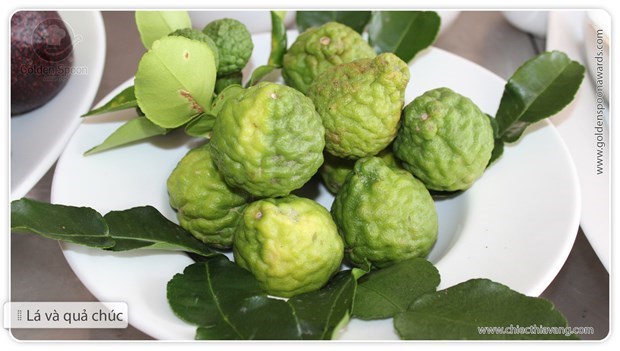
In An Giang, the Khmer people use the leaves and fruit of kaffir
lime for not only seasoning, but also as shampoo, mouthwash for elderly and
children or even to sterilize fish ponds. Some local chefs use it to cook many
kinds of chicken and duck, either grilled, steamed and stewed.
Besides that Phu Quoc’s
boletus mushroom doesn’t attract diners by its good smell, but instead by its
bitter taste. At first the taste is bitter, but finishes sweet. It’s a unique
dining experience.
Fresh mushroom always
tastes more authentic than dried products. Those indicative to Phu Quoc usually
grow under the cover of tea-trees, and appear usually only the first seven to
10 days of the rainy season in Phu Quoc and Kien Giang forest. Huynh Ngoc
Chanh, deputy chief of operations and captain of Laveranda Resort has gone out
to look for them since very early in the morning after he finishes his shift.
With this, he has the main
ingredient for the dish (pigeon stewed with Phu Quoc boletus mushroom), but
there are still many things to do. Although knowing that the mushroom is very
useful for the nervous system, cardiovascular and liver functions, according to
food medicine, but it are extremely bitter at first. It is double or triples
the amount of bitterness than that of bitter melon, so it will be a huge
challenge for anyone who has never cooked with it before. Those who can handle
or are used to the taste can confidently wait for the sweetness.
However, if people do not
enjoy such bitterness then they will not enjoy the taste of this dish. So to be
able to serve it to everyone Chef Chanh eliminates the bitterness by soaking it
twice in salty water. It is then cut into small pieces and stir-fried with fish
sauce and sugar. It is then mixed with minced pork plus jelly ear mushroom and
green pepper. The mixture is stuffed inside the pigeon.
Chef Chanh also made a new
dessert invoking island life by using Phu Quoc rose myrtle served with caramel
sauce. The sauce was made of the rose myrtle, which had a slightly acidic and
mildly sour taste, indicative of the plant. Its reddish-brown color sat beautifully
atop the sweet and fatty layer of cream Food Artisan and Professional Judge Bui
Thi Suong was very impressed by this dish.
Using flower to worship Buddha
Going to Ho Chi Minh City
and the rest of the Southeast region the competition of key spices used by the
team added drama to the contest. Especially in Saigon where there is access to
nearly all the ingredients found throughout the country, plus those that are
imported. For instance, Mang Den wild pepper which belong Kon Plong district
and Kon Tum province is available and was used.
Professional Judge Choi
Thi Trieu highly appreciated the flavor of lemongrass pepper which was used to
season a grilled sturgeon dish and chicken cooked with fruit of lemongrass by
Van Thanh Tourist Area team.
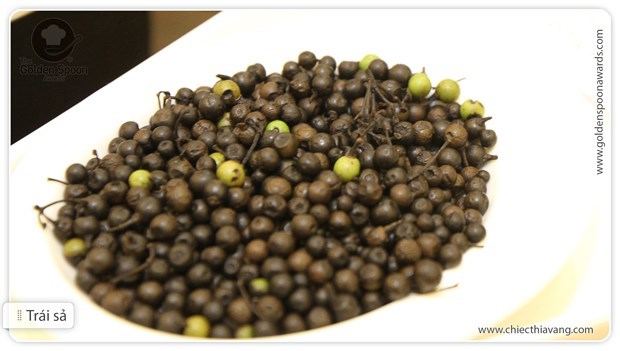
Its shape looks like pepper and at closer inspection shows a
very smooth hair on the outside. Put it near the nose we will hear very strong
smell of lemongrass and lemon essential oils. Often seen at Mang Den district and
the mountainous districts, such as Tay Giang in Quang Nam province. Local
people still call it wild pepper, although its taste is not strong like that of
white pepper. They look exactly the same, but the pepper in Quang Nam province
(near Truong Son Mountains) smells of lemon and lemongrass, and is twice or
thrice as strong than pepper in Kontum province. It has better taste,
accompanied with bitterness and minty quality. Maybe this is due to the soil
that makes these two kinds of pepper have such a difference in taste.
The experience of some housewives in Quang Nam province who
often use this lemon pepper is to use the whole pepper instead of grinding it.
Depending on the dish, it may be left in throughout or it may be removed before
serving.
Also bringing new spices to the competition
was Chef Duy Anh Le Vo, Binh Quoi I Tourist Zone, who used the fruit from
Artocarpus tonkinensis tree for cooking with chicken called “Gà tre”. It is considered to people in
the Central region to be quite medicinal i properties, and is a spice used
flexibly within many dishes, such as stewed with perch, snakefish or in soup.
However it is also known for its use among the elders who chew the bark of the
root.
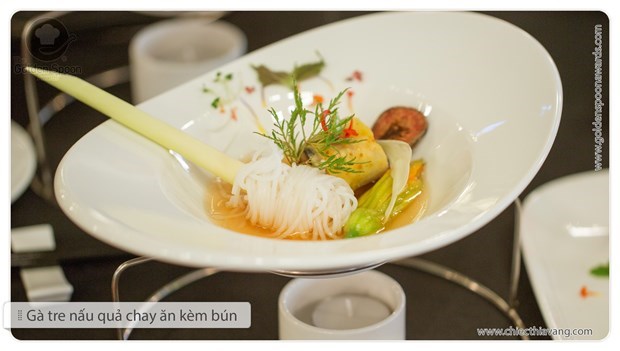
Chef Duy said that when the fruit is ripe it will look pale
yellow and have a sour taste. It is very aromatic, which is what gave him the
inspiration to use it in his menu. When cooked with chicken it emanates a
beautiful fragrance; the broth is very light and has a light yellow color. It
was not only used as an ingredient, but was also sliced for use in the
presentation.
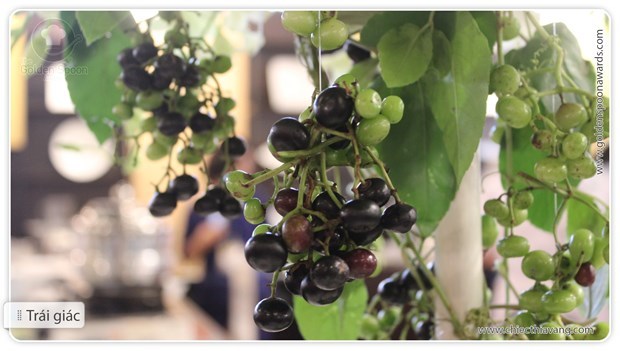
Meanwhile Chef Cuong Nhu
Nguyen from Kim Do Hotel took even more risk when he used fox grape as a key
ingredient for all dishes in his menu. This fruit is green when young with an
acrid taste, but when it ripens it turns black and dark purple inside, similar
like grapes. Folklore mentions that “ripe fox grape turns black and loving
someone means keeping your word no matter what,” and Chef Nhu Cuong used his
knowledge about folk stories when he created his dishes. Its purple color made
the salad very beautiful; the sour taste of the fox grape in the soup made of
eel, which has is a different sour than what you get from tamarind. A sauce
made from the fruit was served alongside chicken rolled with sticky rice, and a
jam was served with cassava cake plus a drink with syrup made from the fruit.
Arid soils and land grow the best ingredients
As the competition went to the South Central region where it is
very windy and sunny, many people crave to eat the youngest part of “cây dít” tree, which belongs to the
orange family. It grows wild and in the highlands of Son Hoa in Phu Yen
province. Wild hen or rooster is perfect for a dish cooked with “lá dít”.
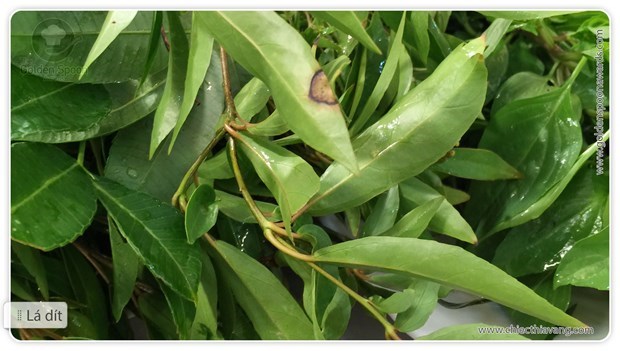
It not only adds sourness to the dish, but
the resin from the tree also also smells nicely, like ripe mangosteen.
Chef Tru Cong Nguyen has 16 years of experience and currently
works in Yasaka Huong Sen Hotel told us that he started studying this particular
type of leaf and has been using it often as of late. “Lá dít” cooked with chicken is quite suitable because the chicken
cooked with river leaf or the youngest part of “xiêm chili” is quite common. The dish requires the natural green of
the leaf remain, including its typical aroma and slightly sour taste. To do
this, when the chicken is nearly cooked the flame is increased and the “lá dít” is added. If it is only simmered
then the leaf turns black and the flavor is altered.
This leaf tastes slightly sour, so it doesn’t overpower the
sweetness of the chicken. Besides chicken, “lá dít” also pairs well with beef,
ostrich or fish. With beef, Chef Cong Tru said “lá dit” contains organic acids
that help to tenderize the meat, and also gives a very specific taste.
Currently, this plant is being used more by local people and many have planted
the tree. The tree doesn’t produce fruit, so after just a few months the
branches will be ready for harvest and continue to grow.
The unique tastes of the jungle and mountain
The preliminary round held in Nha Trang was also a meeting point
for cuisine from the jungle, mountain and seafood. Chef from the Highland
region impressed judges with new and strange spices. Chef of Anh Duong
restaurant, Kon Tum province, prepared dishes made of yellow ant’s eggs. A new
and strange spice appeared in the appetizers, which is “Đọt mây” from Gia Rai province. Chef Quang Thanh said that this
dish is very common to the people of Gia Rai, and it expresses their respect of
nature. Only for important parties or festivals will the leader of the village
give permission to villagers to go to the jungle and get it, but just to take
enough to cook for the party and not allow them to cut without haphazardly. The
salad in the Highland region still keeps its bitter taste. When brought into
the mainstream, chefs must invent techniques to release the bitter, usually
through grilling or steaming the “Đọt mây”.
It is sliced thinly, then rolled with chicken and finally sauteed. Spices that
served with this dish are salt, grounded basil leaves and mixed with green
chili. Judge Choi Thi Trieu complimented “I am glad to see dishes that have a
unique taste and new flavors in a menu with reasonable structure. “Đọt mây” usually is very bitter but
after briefly cooked this strong bitterness was eliminated.
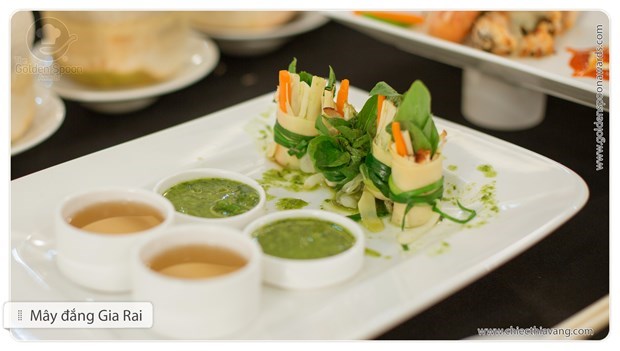
Chef Pham Van Le and colleagues at Ana Mandara Villas Dalat also
impressed judges with a chicken dish served with beehive mushroom sauce. This
is the mushroom that grows plentifully outside of Dalat city and is collected
by ethnic minority, prepared and sold to restaurants. This mushroom is quite
expensive (about VND 2 million per kilogram). The fungus grows in the mountains
of suburban forests. It has a strong flavor and is also used for decoration.
As highlighted points for menu of other teams, unique leaves and
fruits such as “Trái gùi”, roots of
beautyberry, creeping herb or wild banana which can be used to make sauce or
salad with new and interesting tastes and flavors.
And there are so many other unique herbs that are hidden
somewhere and wait to display themselves in the semi-final round - southern
region - on October 27 and 28, 2015 in Van Thanh Tourist area, Binh Thanh
District, Ho Chi Minh City.
It promises to be an exciting and flavorful adventure.
Tan Trung